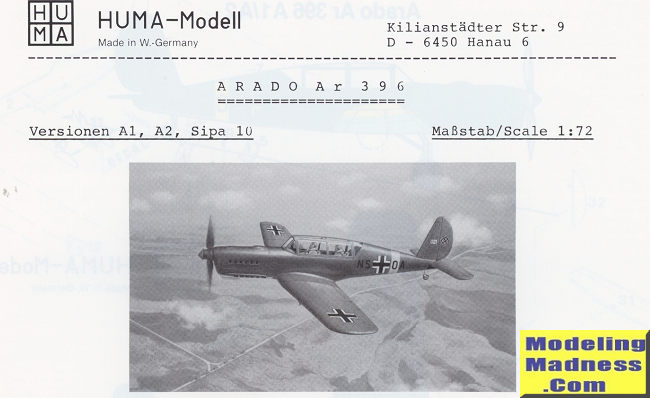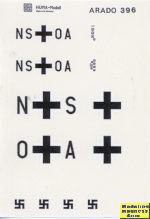
| KIT #: | HM0023 |
| PRICE: | £ |
| DECALS: | One option |
| REVIEWER: | Scott Van Aken |
| NOTES: |
1980s release |

| HISTORY |
The Arado Ar 396 was a training aircraft developed from the successful Arado Ar 96B, but using as little metal as possible in its construction. Despite its name the Ar 396 was developed in France, and none reached the Luftwaffe.
The Arado Ar 96 was a low-wing monoplane trainer, off all metal construction and built with light alloys. It was the standard advanced trainer in the Luftwaffe during the Second World War, and work began on an improved version, the Ar 296, which would have been powered by the Argus As 411 engine.
By 1944 Germany was running short of strategic materials such as light alloys, and so work moved onto the Arado Ar 396, a version of the Ar 296 re-engineered to use as little wood as possible. The new aircraft was designed by the Société Industrielle pour l'Aéronautique, or SIPA, in occupied France. Although work on the new aircraft proceeded at some speed, the Allied invasion moved quicker, and the new aircraft didn't make its maiden flight until 29 December 1944, after the SIPA works near Paris had been liberated.
The Ar 396 was a simplified version of the Ar 96, with hand operated flaps and a semi-retractable undercarriage. The instructor and pupil sat in tandem in the long glazed cockpit. Two versions were to have been produced - the Ar 396A-1 fighter trainer, with a single machine-gun, bomb racks and gun sight and the un-armed Ar 396A-2, designed for blind flying training.
SIPA built 200 Ar 396s after the war, as the S.10, S.11 and S.12. During the war the Letov factory in Czechoslovakia also began work on the Ar 396, with records showing that four reached the Luftwaffe, but none made it to units.
| THE KIT |
There is a single sprue of light grey plastic and an injected canopy. The plastic is somewhat soft with soft detailing in terms of panel lines. While no actual flash is on the parts, the mold seams are generally larger than you'd expect on more mainstream kits.
There is no interior detailing on the inside of the fuselage and your interior is basically a floor with seats into which you are to place two crew figures. A pair of control sticks and instrument panels that take decals will complete the inside. After installing the engine face piece, the fuselage halves can be closed.

Having a one piece wing and tailplane speeds construction. The rudder is also separate. There is a forward cowling piece onto which the prop assembly is attached prior to installation if you want the prop to spin. Most of the rest of the build concentrates on the landing gear. There are bomb racks and bombs if you wish to install those. Last bits are the oil cooler and exhaust.
| CONCLUSIONS |
| REFERENCES |
http://www.historyofwar.org/articles/weapons_arado_ar_396.html
Kit instructions
March 2020
Copyright ModelingMadness.com. All rights reserved.
If you would like your product reviewed fairly and fairly quickly, please contact the editor or see other details in the Note to Contributors.
Back to the Main Page Back to the Review Index Page Back to the Previews Index Page